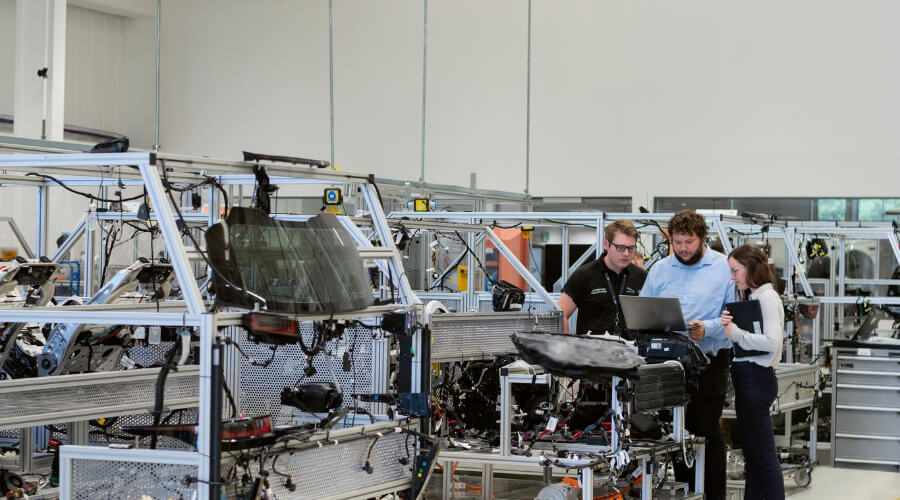Configuration management aims to help engineering organizations so that they can manage the infrastructure as well as provide a strategy for sustainable development. The basic principle for effective configuration management are:
- Protect critical data and other resources
- Monitor and control software development procedures and processes
- Provide value to customers
- Automate where automation is possible
- Provide traceability within the enterprise
- Develop a strategy for how new hardware will be provisioned and configured
- Manage hardware configurations effectively and with a strategy
What is Configuration Management?
Configuration management is a very important element of a business module because it covers the technical and administrative activities that are connected with the creation, maintenance, controlled change, and quality control of the working scope of a business. Most of the time configuration management is regarded as asset control and it is required in situations where one or more versions of a deliverable are created.
Five Disciplines For Both Hardware And Software Configuration Management

There are five distinct disciplines available that are carried out as policies and procedures for establishing a business and performing a standard change-management process. Let’s take a look at them!
CM Planning and Management: It’s a formal plan to guide the CM program that includes the below items –
1. Personnel
2. Responsibilities and resources
3. Training requirements
4. Administrative meeting guidelines
5. Baselining processes
6. Configuration control
7. Configuration-status accounting
8. Naming conventions
9. Audits and reviews
10. Subcontractor/vendor CM requirements
Configuration Identification (CI): This step is consists of setting and maintaining baselines and defining the systems or subsystem architecture, components, etc. Actually, it is the process to identify any changes to any part of a system. In this step, the changes are also documented and later tracked through design, development, testing, and final delivery. Configuration Identification establishes and maintains the plan for Configuration Status Accounting of a system. The configuration items are:
1. Development
2. Production
3. Deployment
4. Operational support
Configuration Control: This discipline includes the evaluation of all change requests and change proposals. It also includes subsequent approval or disapproval of the change request. Moreover, it also covers the process of controlling some items of a system’s design. They are:
1. Design
2. Hardware
3. Firmware
4. Software
5. Documentation
Configuration Status Accounting: This step includes the process of recording and reporting configuration item descriptions that includes hardware, software, firmware, etc. It also records all the departures from the baseline during design and production. If there are any suspected problems then you can easily measure the verification of baseline configuration and approved modifications.
Configuration Verification and Audit: In this step, there will be an independent review of hardware and software. The main purpose of this audit is to assess the compliance with established performance requirements, commercial and appropriate military standards, and functional, allocated, and product baselines. This type of audit also verifies that the system and subsystem configuration documentation complies with the functional and physical performance characteristics before getting into an architectural baseline.
What Are The Standards Supports For Configuration Management?

List of organizations that provide Standards supports for Configuration Management:
1. ANSI Standards – American National Standards Institute
2. ASQ Standards – American Society for Quality
3. ASME Standards – American Society of Mechanical Engineers
4. AIAG – Automotive Industry Action Group
5. Defense Standardization Program, Assist Quick Search
6. EIA Standards – Electronic Industry Alliance
7. EPRI – Electric Power Research Institute
8. European Space Agency Standards
9. FDA – Food & Drug Administration
10. Global Engineering Documents
11. IAQG – International Aerospace Quality Group
12. IEEE Standards – Institute of Electrical and Electronics Engineers
13. IHS Standards Store
14. ILI InfoDisk, Inc. – Worldwide provider of engineering standards and databases
15. Information Handling Services
16. ISO Quality Standards – International Organization for Standardization
16. NATO Standards
17. Navy Electronic Directives System
18. NIRMA -Nuclear Information and Records Management Association
19. NIST -National Institute of Standards and Technology
20. NTIS – National Technical Information Service
21. NSSN – A National Resource for Global Standards
22. RTCA – Radio Technical Commission for Aeronautics
23. SAE International – SAE International
24. Solutions Software Corporation – Has Federal Register, CFR, EPA & lots more on CD-ROM
25. TechStreet
26. USAF ePublishing
27. U.K. Ministry of Defense Standards
28. U.K. Civil Aviation Authority
Aerospace Standards For Configuration Management
1. AS9100C – Advanced Quality System
2. DO 178B – Software Considerations in Airborne Systems and Equipment
3. Alliance for Telecommunications Industry Solutions (ATIS)
4. ATIS 0300250, Operations, Administration, Management & Provisioning (OAM&P) — Extension to Generic Network Model for Interfaces between Operations Systems and Network Elements to Support Configuration Management—Analog and Narrowband ISDN Customer Service Provisioning
5. American National Standards Institute (ANSI)
6. ANSI INCITS TR-47, Information Technology—Fiber Channel-Simplified Configuration and Management Specification (FC-SCM)
7. American Nuclear Society (ANS)
8. ANSI/ANS-3.2-1982, Administrative Controls & Quality Assurance for the Operational Phase of Nuclear Power Plants
9. American Society of Mechanical Engineers (ASME)
10. ASME/NQA-1, Quality Assurance Program Requirements for Nuclear Facilities
11. ASME/NQA-1B-2011, Quality Assurance Requirements for Nuclear Facilities Applications
12. ASME/NQA-2A-1990, Addenda to ASME NQA-2-1989 Edition, Quality Assurance Requirements for Nuclear Facility Applications
13. ANSI/N45.2.11, Quality Assurance Requirements for the Design of Nuclear Power Plants
14. ANSI/N18.7, Administrative Controls & Quality Assurance for the Operational Phase of Nuclear Power Plants
15. ANSI/N45.2.9-1974, Requirements for the Collection, Storage, & Maintenance of Quality Assurance Records for Nuclear Power Plants
16. ANSI/N45.2.13, QA Requirements for the Control of Procurement of Items & Services for Nuclear Power Plants
17. ASME Y14.100, Government/Industry Drawing Practices
18. ASME Y14.24M Types & Applications of Engineering Drawings
19. ASME Y14.34M, Parts Lists, Data Lists & Index Lists
20. ASME Y14.35M, Revision of Engineering Drawings & Associated Documents
21. ASME NQA Committee, Task Group – CM Draft, January 1991
Australian Standards for Configuration Management
1. AS/NZS 3907:1996, Quality Management—Guidelines for Configuration Management
2. Australian Army Configuration Management Manual (CMMAN) Army CM Manual; version 3.0
3. DI(G) LOG 08-4, Configuration Management of Systems and Equipment DI(A) SUP 24-2, Configuration Management Policy within Army [currently being updated for issue as DI(A) LOG XX-X, Configuration Management Policy for Capabilities in the Land Environment]
4. DI(A) LOG 1-33, Integrated Logistic Support and the Army Material Process (currently being updated)
5. The Army Specification Manual (SPECMAN)
6. EMEI Workshop A 850, Modifications, Trial Modifications, and Local Modifications to Equipment
7. MINE WARFARE-STD-499B, Systems Engineering
North American Automotive Industry Standards
1. QS9000, Quality System Requirements (replaced by ISO/TS16949)
2. ISO/TS 16949 “Quality management systems Particular requirements for the application of ISO 9001:2000 for automotive production and relevant service part organizations”
British Standards Institute (BSI) Standards
1. BS 6488, CM of Computer-Based Systems
2. BSI PD ISO/IEC TR 18018, Information Technology—Systems and Software Engineering—a guide for configuration management tool capabilities
3. BS EN 46001-Application of EN 29001 (BS5750: Part 1) to the manufacture of medical devices
4. BS5515:1984- British Code of Practice for Documentation of Computer-Based Systems
5. BS 7799- Information Security Management
6. BS 15000-1 IT Service Management defines the requirements for an organization to deliver managed services of acceptable quality for its customers. Note: replaced by ISO 20000-1?
7. BS 15000-2 IT Service Management best practices for Service Management processes. Note: replaced by ISO 20000-2?
8. BSI PAS 55:2008 “Asset Management”
9. BS EN 13290-5:2001, Space Project Management. General requirements configuration management
Canada – Department Of National Defense (DND) Standards
1. C-05-002-001/AG-00, Aerospace Engineering Change Proposal Procedures
2. D-01-000-200/SF-001, Joint Electronics Type Designation System (JETS)
3. D-01-002-007/SG-001, Requirements for the Preparation of CM Plans
4. D-01-002-007/SG-002, Requirements for Configuration Identification
5. D-01-002-007/SG-004, Requirements for Configuration Status Accounting
6. D-01-002-007/SG-006, Requirements for the Selection of Configuration Items
7. D-01-100-215/SF-000, Specification for Preparation of Material Change Notices
8. D-01-400-001/SG-000, Engineering Drawing Practices
9. D-01-400-002/SF-000, Drawings, Engineering & Associated Lists
10. D-02-002-001/SG-001, Identification Marking of Canadian Military Property
11. D-02-006-008/SG-001, The Design Change, Deviation & Waiver ProcedurÊ
FAQs About Configuration Management
Is Jenkins A CI Tool?
Jenkins is a free and open-source automation server and the main purpose of this tool is to build continuous integration and continuous delivery (CI/CD) pipelines. So you can use this tool for continuous integration without any hesitation.
Is Jenkins The Best CI Tool?
Jenkins is a very widely used tool because it is written in Java that runs on Windows, macOS, and other Unix-like operating systems. Moreover, it’s a free and open-source tool as well as community-supported. All these features make Jenkins the first choice tool for continuous integration.
Is Maven A CI Tool?
No, Maven is not a CL tool. It is a very popular building tool and it helps the building of the project through plugins.
What Are The Key Components Of Configuration Management?
The three key components of configuration management are:
1. Configuration identification (CID)
2. Configuration control (CC)
3. Configuration accounting (CA)
What Are Configuration Standards?
A configuration standard is a document or a collection of documents that decides how the configuration will be for a device. Usually, the device managers are responsible for developing the configuration standards.
What Are The Benefits Of Configuration Management?
Below are some of the key benefits of Configuration Management:
1. Increased efficiency
2. Cost reduction
3. Greater agility and faster problem-solving ability
4. Enhanced system and process reliability
5. Formal policies and procedures
6. Efficient change management
7. Faster restoration of the service if there is any failure occurs
What Is The Role Of A Configuration Manager?
In a configuration management system, a configuration manager plays a very important role because he provides the complete Configuration Management structure and environment to the product development team. Moreover, he also ensures that the CM environment does the product review and makes changes where require as well as a defect of the tracking activities.
References:
1. https://www.toppr.com/ask/question/what-are-the-principles-that-are-basic-for-an-effective-configuration-management/
2. https://www.coursehero.com/file/p2ldc5pt/What-are-the-principles-that-are-basic-for-an-effective-configuration-manageme/
Last Updated on October 25, 2022 by Magalie D.

Magalie D. is a Diploma holder in Public Administration & Management from McGill University of Canada. She shares management tips here in MGTBlog when she has nothing to do and gets some free time after working in a multinational company at Toronto.





